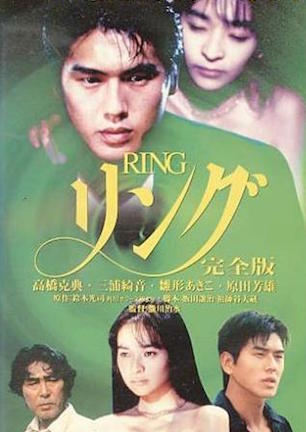Studio: Amuse Video
Director: Chisui Takigawa
Writer: Joji Iida, Taizo Soshigaya, Koji Suzuki
Producer: Ryunosuke Endo, Hidehiro Iwadera, Noriyasu Ueki
Stars: Katsunori Takahashi, Ayane Miura, Yoshio Harada
Review Score:
Summary:
A disgraced reporter and a parapsychology professor investigate the mystery of a cursed video connected to four sudden deaths.
Review:
Before Gore Verbinski and Naomi Watts spooked audiences with the 2002 American remake “The Ring,” there was of course Hideo Nakata’s 1998 Japanese precursor “Ringu” (as well as a sequel, a TV series, another sequel, a Korean remake, a video game, and a prequel, but those are beside the point right now). What some might not be aware of however, is that before the theatrical “Ringu,” there was a 1995 TV version now known as “Ring: Kanzenban,” which was actually the first filmic adaptation of Koji Suzuki’s original “Ring/Ringu” book.
“Ring: Kanzenban,” which translates to “Ring: The Complete Edition,” has to date only appeared on Japanese television, VHS, and LaserDisc, and not since 1997. “Kanzenban” has never been officially released outside of Japan either, though tracking down a copy with fan-sourced subtitles is as simple as a single internet search.
By all accounts, “Ring: Kanzenban” is the most faithful film adaptation of “Ringu,” sticking to the story from Koji Suzuki’s source novel in ways the 1998 and 2002 versions most certainly do not. This means that if everything you know about Sadako Yamamura (or Samara Morgan for English-only fans) comes from the theatrical movies, “Kanzenban” has several surprises in store.
Disgraced newspaper reporter Kazuyuki Asakawa’s niece just died of a sudden heart attack. So did a young motorcyclist stopped in the street next to Kazuyuki’s cab. When Kazuyuki learns of two more teens who dropped dead at the same time under similar circumstances, an impromptu investigation begins and dots connect him to a resort room where these four friends watched a mysterious videotape.
Being the clue the victims have in common, Kazuyuki watches the tape too. As bizarre images flicker onscreen, a supernatural assault surrounds him. Kazuyuki feels fright consuming mind, body, and soul until the video concludes with a warning that viewers will die in seven days.
Kazuyuki takes the videocassette to parapsychology professor Ryuji Takayama, a suspected killer whose association with Kazuyuki is what put the reporter in hot water in the first place. Despite the forewarning of death, Takayama insists on watching the tape and concludes that its curse appears real. Now both men must decipher what the images mean if they are to solve the mystery and save their own lives.
Whatever expectations you take with you into “Ring: Kanzenban,” they should not include seeing a traditional J-horror ghost with stringy hair crawling out of a television screen, or from a well for that matter. As alluded to earlier, this is not the same “Ringu” that film fans have become familiar with.
Subsequent installments in the series often emphasize the videotape, placing it or its footage in prominent scenes to heighten fear factors. The tape still plays an important part in “Kanzenban,” although the objective is less on scare tactics and more on brokering suspense. Here the tape serves mainly as a delivery device to get the mystery moving in a backward direction as Kazuyuki and Takayama piece together Sadako’s story, which is where the movie’s real meat lies.
Sadako is a different beast in “Kanzenban,” figuratively and literally. She appears in a few visions to point accusatorily once or twice, yet she is decidedly not portrayed as anything close to a croaking ghoul.
Sadako’s origin in this instance is steeped in soap opera, much of the movie is, bridging her background with some shock reveals that complicate her character in wickedly intriguing ways. This Sadako is more beautiful, more human, more tragic, and more twisted than usual.
The film has no qualms about loading up on inessential nudity, Sadako in particular favors dropping her top, and even less shame about sweetening a subplot involving incestuous intimacy with misplaced sentimentality. It’s also kind of ridiculous how much ground “Kanzenban” covers with its copious characters and clues linking a long chain together.
Yet you take what you think you know about “The Ring,” factor in made-for-TV status, and “Kanzenban” becomes so brazen in its bizarreness that it is fascinating to see unfold as a thriller. It’s like a Russian nesting doll always ready to reveal one more layer to the plot or to a person. Each pulled curtain usually results in a weirded out “what?” reaction, though in this exception that is a compliment.
It’s an easy matter to poo-poo the production value and implausible parts of the presentation, of which there are plenty. But a big part of what makes “Ring: Kanzenban” oddly transfixing is how its proximity to the late 1980s/early 1990s, TV quality standards, and VHS veneer give a great throwback vibe for a 21st-century viewing (synthesized take on “The Exorcist” theme anyone?).
Franchise faithful have to admit that on uniqueness alone, “Ring: Kanzenban” carves out its place in “Ringu” canon. Sometimes cheesy, sometimes chilling, there is a uniqueness to it that is arguably effective, but inarguably entertaining.
Review Score: 75






It assumes everyone watching must be a dimwit too dense to understand how the most basic storytelling concepts work.